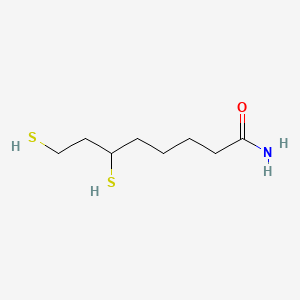| MeSH term | MeSH ID | Detail |
|---|---|---|
| Parkinsonian Disorders | D020734 | 20 associated lipids |
Dihydrolipoamide
Dihydrolipoamide is a lipid of Fatty Acyls (FA) class. Dihydrolipoamide is associated with abnormalities such as Wiskott-Aldrich Syndrome. The involved functions are known as Citric Acid Cycle, Electron Transport, NADH oxidation, Oxidation and Oxidants. Dihydrolipoamide often locates in Mitochondria, Mitochondrial matrix and Chloroplasts. The associated genes with Dihydrolipoamide are Mutant Proteins, Recombinant Proteins, mycothione reductase, Genes, Mitochondrial and alanylproline.
Cross Reference
Introduction
To understand associated biological information of Dihydrolipoamide, we collected biological information of abnormalities, associated pathways, cellular/molecular locations, biological functions, related genes/proteins, lipids and common seen animal/experimental models with organized paragraphs from literatures.
What diseases are associated with Dihydrolipoamide?
Dihydrolipoamide is suspected in and other diseases in descending order of the highest number of associated sentences.
Related references are mostly published in these journals:
| Disease | Cross reference | Weighted score | Related literature |
|---|
Possible diseases from mapped MeSH terms on references
We collected disease MeSH terms mapped to the references associated with Dihydrolipoamide
PubChem Associated disorders and diseases
What pathways are associated with Dihydrolipoamide
There are no associated biomedical information in the current reference collection.
PubChem Biomolecular Interactions and Pathways
Link to PubChem Biomolecular Interactions and PathwaysWhat cellular locations are associated with Dihydrolipoamide?
Visualization in cellular structure
Associated locations are in red color. Not associated locations are in black.
Related references are published most in these journals:
| Location | Cross reference | Weighted score | Related literatures |
|---|
What functions are associated with Dihydrolipoamide?
Related references are published most in these journals:
| Function | Cross reference | Weighted score | Related literatures |
|---|
What lipids are associated with Dihydrolipoamide?
There are no associated biomedical information in the current reference collection.
What genes are associated with Dihydrolipoamide?
Related references are published most in these journals:
| Gene | Cross reference | Weighted score | Related literatures |
|---|
What common seen animal models are associated with Dihydrolipoamide?
There are no associated biomedical information in the current reference collection.
NCBI Entrez Crosslinks
All references with Dihydrolipoamide
Download all related citations| Authors | Title | Published | Journal | PubMed Link |
|---|---|---|---|---|
| Xue F et al. | Transcriptional responses of Leptospira interrogans to host innate immunity: significant changes in metabolism, oxygen tolerance, and outer membrane. | 2010 | PLoS Negl Trop Dis | pmid:21049008 |
| Liang L et al. | Large scale immune profiling of infected humans and goats reveals differential recognition of Brucella melitensis antigens. | 2010 | PLoS Negl Trop Dis | pmid:20454614 |
| Gómez-Baena G et al. | Glucose uptake and its effect on gene expression in prochlorococcus. | 2008 | PLoS ONE | pmid:18941506 |
| van der Lelie D et al. | The metagenome of an anaerobic microbial community decomposing poplar wood chips. | 2012 | PLoS ONE | pmid:22629327 |
| Redanz S et al. | A five-species transcriptome array for oral mixed-biofilm studies. | 2011 | PLoS ONE | pmid:22194794 |
| Garbeva P et al. | No apparent costs for facultative antibiotic production by the soil bacterium Pseudomonas fluorescens Pf0-1. | 2011 | PLoS ONE | pmid:22110622 |
| Harvey RM et al. | A variable region within the genome of Streptococcus pneumoniae contributes to strain-strain variation in virulence. | 2011 | PLoS ONE | pmid:21573186 |
| Xiao Z et al. | Acetoin catabolism and acetylbutanediol formation by Bacillus pumilus in a chemically defined medium. | 2009 | PLoS ONE | pmid:19461961 |
| Charles RC et al. | Comparative proteomic analysis of the PhoP regulon in Salmonella enterica serovar Typhi versus Typhimurium. | 2009 | PLoS ONE | pmid:19746165 |
| Günther S et al. | Knockout studies reveal an important role of Plasmodium lipoic acid protein ligase A1 for asexual blood stage parasite survival. | 2009 | PLoS ONE | pmid:19434237 |
| Dozot M et al. | Functional characterization of the incomplete phosphotransferase system (PTS) of the intracellular pathogen Brucella melitensis. | 2010 | PLoS ONE | pmid:20844759 |
| Li Y et al. | The complete genome sequence of Mycoplasma bovis strain Hubei-1. | 2011 | PLoS ONE | pmid:21731639 |
| Vazquez A et al. | Serine biosynthesis with one carbon catabolism and the glycine cleavage system represents a novel pathway for ATP generation. | 2011 | PLoS ONE | pmid:22073143 |
| Mochel F et al. | Early energy deficit in Huntington disease: identification of a plasma biomarker traceable during disease progression. | 2007 | PLoS ONE | pmid:17653274 |
| Castro H et al. | Mitochondrial redox metabolism in trypanosomatids is independent of tryparedoxin activity. | 2010 | PLoS ONE | pmid:20838623 |
| Chadwick W et al. | Minimal peroxide exposure of neuronal cells induces multifaceted adaptive responses. | 2010 | PLoS ONE | pmid:21179406 |
| Wang Q et al. | Genome sequence of the versatile fish pathogen Edwardsiella tarda provides insights into its adaptation to broad host ranges and intracellular niches. | 2009 | PLoS ONE | pmid:19865481 |
| Jiang H et al. | Global analysis of gene expression profiles in developing physic nut (Jatropha curcas L.) seeds. | 2012 | PLoS ONE | pmid:22574177 |
| Bruant G et al. | Genomic analysis of carbon monoxide utilization and butanol production by Clostridium carboxidivorans strain P7. | 2010 | PLoS ONE | pmid:20885952 |
| Spalding MD and Prigge ST | The amidase domain of lipoamidase specifically inactivates lipoylated proteins in vivo. | 2009 | PLoS ONE | pmid:19812687 |
